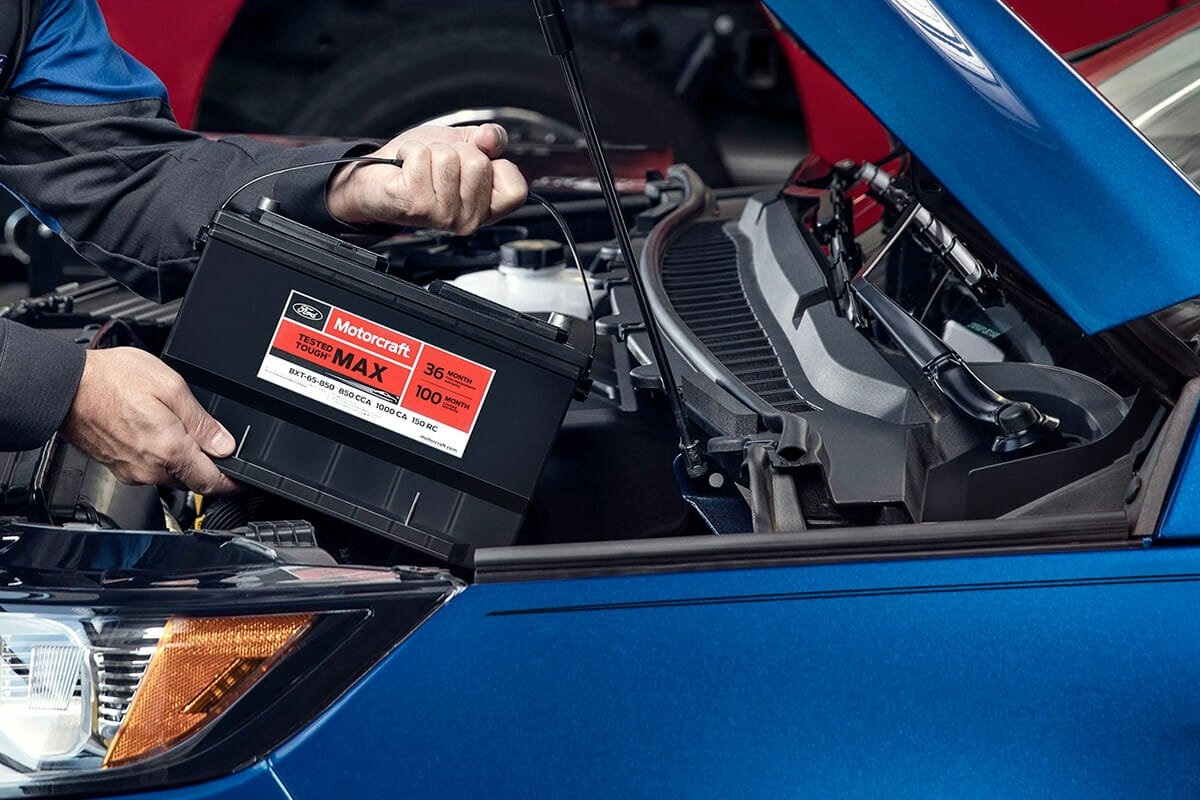How to Measure Battery Health in Used Ford Trucks?
When purchasing used Ford trucks or maintaining your current one, battery condition is a critical factor often overlooked until problems arise. A properly functioning battery is essential for reliable starting, especially during cold winter months. This guide outlines practical methods to accurately assess battery health in used Ford trucks, from F-150s to Super Duty models, […]
When purchasing used Ford trucks or maintaining your current one, battery condition is a critical factor often overlooked until problems arise. A properly functioning battery is essential for reliable starting, especially during cold winter months. This guide outlines practical methods to accurately assess battery health in used Ford trucks, from F-150s to Super Duty models, using simple tools and techniques.

Ford Truck Battery Specifications
Ford trucks utilize different battery types and specifications depending on model year and engine type:
Standard Gasoline Engine Models
- F-150 (2010-2020): 12V, typically 650-850 Cold Cranking Amps (CCA)
- F-250/F-350 (2008-2020): 12V, typically 750-950 CCA
Diesel PowerStroke Models
- 7.3L PowerStroke: Dual 12V batteries, 750+ CCA each
- 6.0L/6.4L/6.7L PowerStroke: Dual 12V batteries, 850+ CCA each
Hybrid Models
- F-150 PowerBoost: 12V starter battery plus high-voltage lithium-ion pack
Understanding the correct specifications for your specific truck is essential before testing, as applying incorrect standards may lead to erroneous conclusions.
Essential Tools for Battery Measurement
Proper battery assessment requires specific tools:
- Digital Multimeter: For measuring voltage (accuracy to 0.01V preferred)
- Battery Load Tester: For testing under load conditions
- Battery Hydrometer: For checking electrolyte specific gravity in conventional batteries
- Battery Cleaning Tools: Wire brush and baking soda solution
- Safety Equipment: Gloves and eye protection
For advanced diagnostics, a scan tool that can monitor charging system operation provides additional insights into alternator performance and battery condition.
Step-by-Step Battery Testing Procedure
1. Visual Inspection
Begin with a thorough visual assessment:
- Check for corrosion on terminals
- Look for bulging or cracking of the case
- Examine mounting security
- Inspect cable condition and terminal tightness
2. Resting Voltage Test
This fundamental test measures battery state of charge:
- Ensure the truck has been off for at least 1 hour
- Connect multimeter to battery terminals (red to positive, black to negative)
- Record voltage reading
- Interpret results:
- 12.6V or higher: Fully charged
- 12.4V: Approximately 75% charged
- 12.2V: Approximately 50% charged
- 12.0V: Approximately 25% charged
- Below 12.0V: Discharged or failing
3. Load Testing
This critical test evaluates the battery’s performance under load:
- Ensure battery is at least 75% charged (12.4V+)
- Connect load tester according to manufacturer instructions
- Apply load equivalent to half the CCA rating for 15 seconds
- Monitor voltage during test
- Healthy batteries maintain above 9.6V under load
- Note how quickly voltage recovers after load is removed
4. Specific Gravity Testing (Conventional Batteries Only)
For non-sealed batteries with removable caps:
- Remove cell caps carefully
- Draw electrolyte into hydrometer from each cell
- Record readings (proper range is typically 1.265-1.299)
- Variation greater than 0.050 between cells indicates problems
5. Charging System Test
Verify the alternator is properly charging the battery:
- Start the truck
- Measure voltage across battery terminals at idle (should be 13.2-14.7V)
- Increase engine RPM slightly and observe if voltage increases appropriately
- Turn on headlights, heater fan, and other accessories
- Voltage should remain above 13.0V with accessories running
Special Considerations for Different Ford Truck Models
F-150 with Start-Stop Technology (2018+)
These models use Absorbent Glass Mat (AGM) batteries that require:
- Special load testing procedures
- AGM-compatible chargers if recharging
- Scan tool registration if replacing
PowerStroke Diesel Models
Dual battery systems require:
- Testing each battery individually
- Checking interconnection cables for resistance
- Verifying both batteries have matched characteristics
- Testing glow plug system draw
F-150 PowerBoost Hybrid
The conventional 12V battery in hybrid models should be tested using standard procedures, but note:
- The high-voltage battery requires specialized diagnostic equipment
- The 12V battery may receive charge from the high-voltage system
- Start-stop functionality affects testing parameters
Results and Decisions
After completing the tests, evaluate the battery based on these criteria:
Replace the battery if:
- Resting voltage is below 12.4V and doesn’t improve with charging
- Load test voltage drops below 9.6V
- Specific gravity varies more than 0.050 between cells
- Case shows damage or significant bulging
- Age exceeds 5 years in extreme climate regions
Consider reconditioning if:
- Battery holds charge but shows slight capacity reduction
- Terminals show corrosion but posts are in good condition
- Specific gravity is low but consistent across cells
How to Maintain Ford Truck Batteries
Extend battery life with these practices:
- Clean terminals every 6-12 months
- Check electrolyte levels in conventional batteries quarterly
- Apply terminal protectant spray after cleaning
- Secure battery hold-downs to prevent vibration damage
- Use a maintainer during extended storage periods
- Minimize short trips that don’t fully recharge the battery
By following these testing procedures, you can accurately assess battery condition in any used Ford truck, ensuring reliable starting performance and preventing unexpected failures.
Frequently Asked Questions
How do I access the batteries in a Ford PowerStroke diesel truck?
- Most trucks have dual batteries located under the hood. In 6.0L and 6.4L models (2003-2010), both batteries are on the driver’s side. In 6.7L trucks (2011+), one battery is on each side of the engine. Always disconnect the negative terminal first when servicing these systems, and reconnect it last when reinstalling.
What is the expected battery lifespan in Ford trucks?
- Batteries typically last 3-5 years under normal conditions. However, extreme climates can significantly impact longevity. In very cold regions, batteries may last only 3 years, while temperate climates might see 5+ years of service. Diesel applications often experience shorter battery life due to higher starting demands.
Can I test a Ford F-150 PowerBoost hybrid 12V battery the same way as conventional trucks?
- Yes, you can test the 12V battery using standard procedures, but with some caveats. The hybrid system may mask battery issues by supplementing power from the high-voltage system. For accurate results, ensure the truck has been off for at least 2 hours before testing the 12V battery, and be aware that the battery management system may affect charging patterns.
What voltage should my Ford truck alternator produce?
- A properly functioning alternator should produce between 13.2V and 14.7V at idle with a fully warmed engine. When accessories are running, the voltage should remain above 13.0V. Modern Ford trucks use smart charging systems that may vary voltage based on battery condition and electrical demands, so brief fluctuations are normal.
How do I test dual batteries in a Ford Super Duty to ensure they’re matched?
- To test dual batteries for proper matching, measure the voltage of each battery individually after the truck has been off for at least 2 hours. The difference should not exceed 0.2V. Then perform load tests on each battery separately. Both should perform similarly under load. If one battery consistently tests weaker, replace both batteries as a matched pair for optimal performance.
Why does my Ford truck battery measure 12.6V but still fail to start the engine?
- Voltage alone doesn’t tell the complete story. A battery can show proper voltage (12.6V) at rest but lack the amperage (current) needed for starting. This condition, called “surface charge,” can mask internal damage or sulfation. Always perform a load test, which stresses the battery and reveals its true condition by measuring voltage under load. A healthy battery maintains above 9.6V during a proper load test.
How do I properly test a Ford F-150 with Auto Start-Stop technology?
- Models with Auto Start-Stop use AGM (Absorbent Glass Mat) batteries that require special testing procedures. These batteries should maintain higher voltages under load than conventional batteries. When load testing, a healthy AGM battery should maintain above 10.2V (versus 9.6V for conventional batteries). Additionally, use only AGM-compatible chargers for recharging, and be aware that replacement requires registration with a scan tool.
What impact do aftermarket accessories have on battery testing in Ford trucks?
- Aftermarket accessories like winches, light bars, and audio equipment can significantly affect battery testing results. Before testing, disconnect or account for parasitic drains from these accessories. A higher-than-normal drain can cause premature battery failure. When upgrading a used truck with significant accessories, consider upgrading to a higher capacity battery or dual battery system, even if the original battery tests well.
How do cold temperatures affect battery testing results in Ford trucks?
- Cold temperatures significantly impact battery performance and testing. Battery capacity can decrease by up to 50% at -18°C compared to 25°C. When testing in cold conditions, add 10% to the minimum voltage threshold for each 10°C below freezing. For accurate assessment in winter conditions, attempt to warm the battery to at least 4°C before testing, or compensate accordingly in your interpretation of results.
What’s the difference between testing conventional and AGM batteries in newer Ford trucks?
- AGM (Absorbent Glass Mat) batteries, used in newer trucks with start-stop technology, require different testing parameters than conventional batteries. AGM batteries typically maintain higher voltages under load, recover more quickly after load removal, and cannot be tested with a hydrometer. When load testing AGM batteries, minimum acceptable voltage under load is approximately 0.5V higher than conventional batteries. Always use equipment with AGM-specific settings when available.



